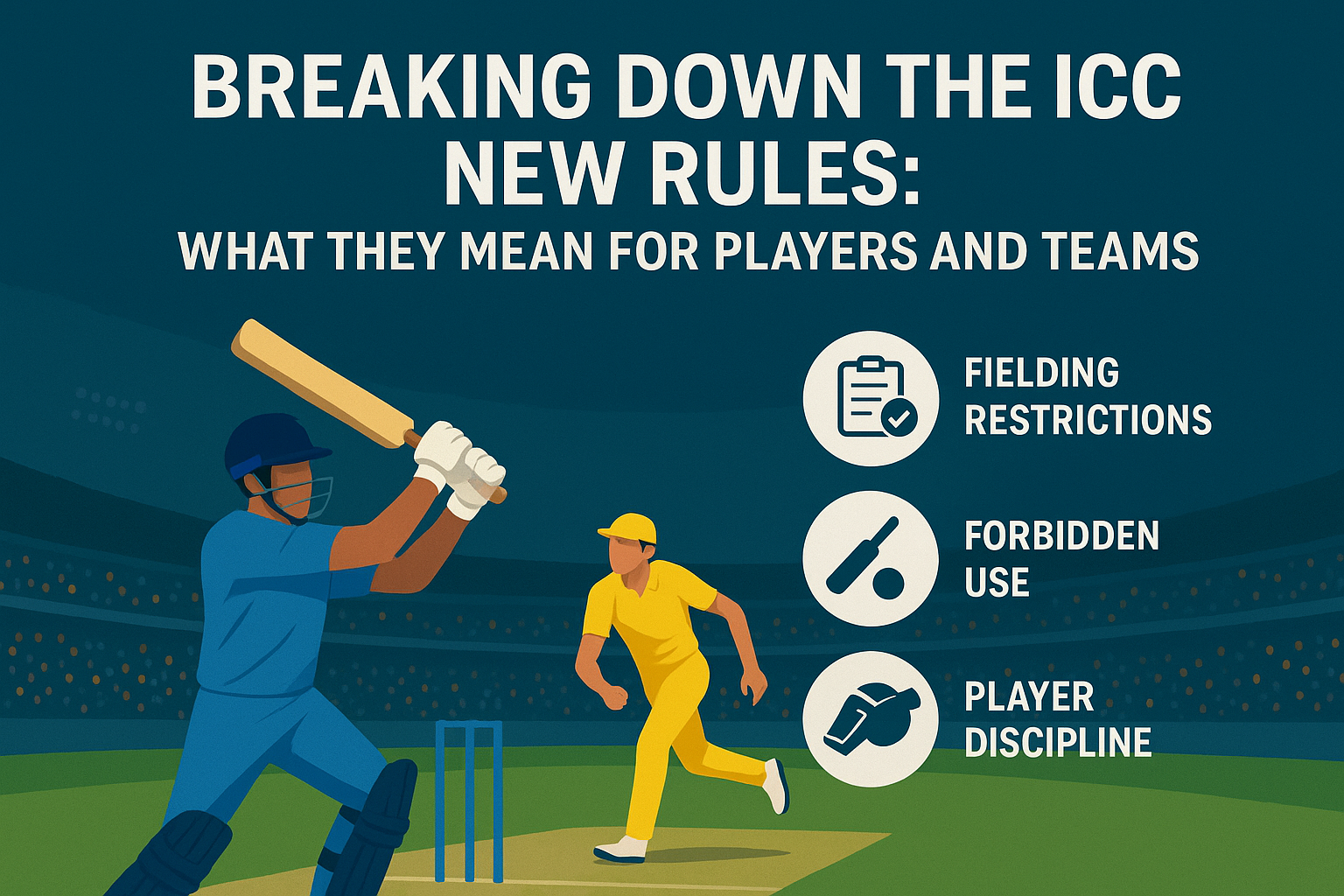Sports
Breaking Down the ICC New Rules: What They Mean for Players and Teams

The ICC dropped a wave of new playing conditions this summer, and many are wondering how this would impact player performance. The new rules are somehow a reset for how cricket gets played, coached, and watched. Tests are getting a stopwatch, ODIs are drifting toward one-ball tactics, and everything in between is getting tweaked for fairness and edge.
Here’s what’s going on, how it changes the game, and what players and teams need to do differently from here on.
Test Cricket Gets a Stopwatch, and That Changes Everything
Let’s cut to the most visible change. The “stop clock” is now mandatory in Test cricket. Fielding sides must begin each over within 60 seconds of the previous one finishing. Umpires will flash two warnings; a third delay triggers an immediate five-run penalty. This rule resets every 80 overs, usually aligned with a new-ball change.
Remember when Ben Stokes slammed the old over-rate system? He complained about his team finishing games early yet getting fined and losing points. He argued that the ICC doesn’t adapt to different playing conditions, especially in spin-friendly Asia.
Now, the delay stops mattering. For captains, it means mandatory on-the-money field changes and tighter coordination between the bowler, the captain, and the coaching staff. It stops tactical time-wasting, but raises the urgency of preparation. So, more thinking and less stalling.
Fairness and Integrity: Drips Everywhere
Some rule tweaks are also seen as FIFA-level in terms of fairness. They’re not exactly drastic, but they touch margins in game ethics.
- Ball change policy: Saliva ban stays, but ball change isn’t automatic. Umpires now assess visible condition change first. If there’s no change but the ball does weird things, the batting side gets five runs.
- DRS protocol: For combined on-field and player reviews, DRS now follows the actual order of events. If LBW came before caught-behind, it gets priority. This then avoids contradictions.
- Deliberate short runs: Still a five-run penalty, but now the fielding captain gets to pick which batter faces the next ball.
- Boundary catch rule: You have to land fully inside the boundary after taking a catch. No bunny hops or partial touches will be allowed.
These feel like fine-tuning, but they can change play habits. So, players must think twice before pushing for that short run, and umpires must stay sharper with decisions.
White-Ball Cricket: Tweaks That Can Also Change Player Strategies
These three changes here look small, but they can have big strategic fallout:
One-Ball Rule: ODIs now allow the fielding team, after 34 overs, to pick one ball to use for the rest of the innings. This gives spin and reverse swing value, especially in late overs.
Concussion Sub Protocols: Teams now have to pre-nominate injury subs by role: wicketkeeper, batter, spin, pace, all-rounder. It keeps replacements fair, consistent, and not home-ground flexibility.
Wide Ball Trial: A trial rule in T20s and ODIs: if the batter is moving before the crease and you bowl behind them between the popping crease and protected area marker, it’s not a wide. It’s meant to reduce fussy wide calls and add flow to the match.
These new rules are already telling how tactical discussions in coaching circles, analytics platforms, and cricket media coverage could change. Fans tracking upcoming series can visit 10CRIC to follow the latest match odds and get an idea of expert predictions that factor in how the updated rules could affect player performance.
What Teams and Players Need to Do
The new ICC rules might look straightforward, but they change how players prepare and how matches are managed.
Test captains now have less breathing room between overs, so they need cleaner, faster decision-making. That means no more drawn-out huddles or unnecessary delays. Bowlers have to tighten their pre-delivery routines, and fielders need to stay switched on between overs instead of drifting.
In ODIs, the one-ball rules adds real value late in the innings. Death bowlers who can get reverse swing will be more dangerous, so teams should identify and groom specialists for that phase. Batters facing it have to prepare for movement under pressure, not just pace and yorkers.
Batters who shuffle early in their stance should anticipate that bowlers would target the leg-side channel more frequently during the wide-ball trial without worrying about getting called wide. Counterstrategies are then necessary for this change, such as controlled placement or utilizing the bowler’s angle against them.
Final Take
These ICC changes can definitely change so much of how players perform in major tournaments. We’ll see all these applied in tournaments and matches like the World Test Championship, Bilateral ODI and T20I Series, International ICC Tournaments like the Champions Trophy, and Domestic First-Class Matches. Many of those will start this year, so it will be interesting to see what cricket will look like next year.
-

 Tech1 year ago
Tech1 year agoHow to Use a Temporary Number for WhatsApp
-

 Business2 years ago
Business2 years agoSepatuindonesia.com | Best Online Store in Indonesia
-

 Social Media1 year ago
Social Media1 year agoThe Best Methods to Download TikTok Videos Using SnapTik
-

 Technology1 year ago
Technology1 year agoTop High Paying Affiliate Programs
-

 Tech10 months ago
Tech10 months agoUnderstanding thejavasea.me Leaks Aio-TLP: A Comprehensive Guide
-

 FOOD12 months ago
FOOD12 months agoHow to Identify Pure Desi Ghee? Ultimate Guidelines for Purchasing Authentic Ghee Online
-

 Instagram3 years ago
Instagram3 years agoFree Instagram Auto Follower Without Login
-

 Instagram3 years ago
Instagram3 years agoFree Instagram Follower Without Login




















